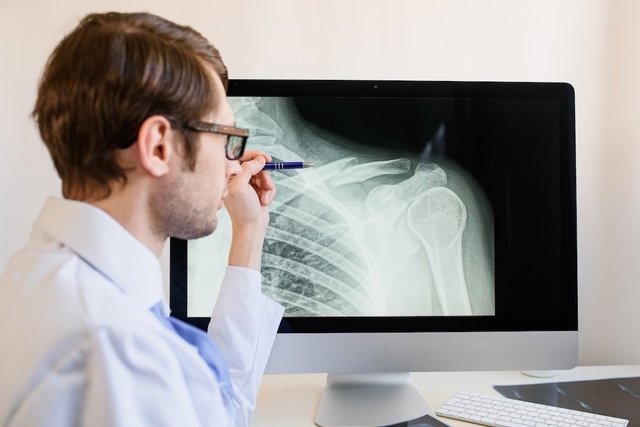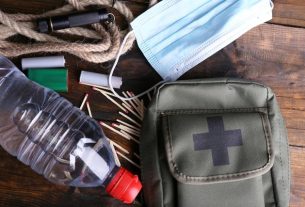A clavicle fracture is usually caused by impacts on the shoulder, such as falls or car, motorcycle or bicycle accidents, for example, and can be identified through symptoms such as shoulder deformity, intense pain, swelling or difficulty in lifting the arm.
The clavicle is a bone that connects the arm to the trunk of the body, helping to support the weight of the arm, in addition to protecting nerves and blood vessels that supply the arm, with fractures of this bone being one of the most common and frequent types.
Broken collarbone treatment is carried out by an orthopedist and involves the use of medication to alleviate symptoms, immobilization of the arm with a sling, physiotherapy sessions or surgery.

Clavicle Fracture Symptoms
The main symptoms of a broken collarbone are:
- Noise or popping noise when the clavicle breaks;
- Intense pain and local swelling;
- Difficulty moving or lifting the arm;
- Deformity of the location, such as a drooping or forward shoulder;
- Protuberance under the skin, at the site of the fracture;
- Increased sensitivity at the site and hematoma, in some cases.
If you suspect a broken collarbone, it is not recommended to try to put the bone back in place, as this could worsen the damage caused by the fracture, or injure local nerves or blood vessels.
Therefore, it is recommended to go to the emergency room immediately so that the diagnosis can be made and the most appropriate treatment can be started. Find out what first aid should be like for fractures.
Don’t ignore your symptoms!
How to confirm the diagnosis
The diagnosis of a broken collarbone is made by the general practitioner or orthopedist at the hospital through evaluation of symptoms, physical examination and history of trauma, accidents or falls.
To confirm the diagnosis, the doctor must request an X-ray to identify the location of the fracture, type and severity, as well as whether there is any other broken bone.
In addition, the doctor may also request a CT scan, MRI or ultrasound, in order to check possible damage to blood vessels, muscles, ligaments or nerves, in addition to allowing surgery to be planned, if necessary.
Possible causes
A broken collarbone can be caused by:
- Direct impact on the clavicle, such as falling on the shoulder or an outstretched arm;
- Shoulder blows due to contact sports;
- Car, motorcycle or bicycle accidents.
Furthermore, a clavicle fracture can also occur in a baby during birth, as it passes through the birth canal.
Types of clavicle fracture
The main types of clavicle fractures are:
- Joint fracture: where it breaks into several pieces, requiring surgery;
- Transverse fracture: easier to consolidate, with the need to just use immobilization;
- Oblique fracture: Depending on the angle, surgery may be necessary.
In addition, a clavicle fracture can also be classified according to the region of the bone affected, as a fracture of the medial, middle or lateral third, with a fracture of the middle third, which is the middle of the bone, being the most common type. .
How the treatment is carried out
The treatment of a broken clavicle must be carried out with the guidance of an orthopedist, and depending on the type and severity of the fracture, in addition to the presence of injuries to muscles, ligaments, nerves or blood vessels.
The main treatments for broken collarbone are:
1. Use of medicines
The use of anti-inflammatory or analgesic medications, such as paracetamol or ibuprofen, may be recommended by your doctor to alleviate the pain and discomfort of a clavicle fracture.
Other medications that may be indicated are opioids, which are more powerful analgesics, recommended by the doctor in cases of very intense pain or pain that does not improve with common analgesics, and should be used for a short period of time.
2. Application of cold compresses
Applying cold compresses to the area for 2 to 3 days after a collarbone fracture can help reduce swelling and relieve pain. Understand when cold compresses are indicated.
To make a cold compress, you must place ice inside a thermal bag or place the gel bag in the freezer to cool, and then wrap it in a clean, dry towel and apply it to the shoulder, leaving it to act for 15 to 20 minutes, 3 to 4 times a day.
3. Immobilization of the arm
Immobilizing the arm, with a sling or figure-8 splint, allows the clavicle to remain in the correct location, accelerating the healing of the bone.
Immobilization should be maintained for approximately 6 to 12 weeks in the case of adults, or up to 3 to 6 weeks in the case of children.
4. Physical Therapy for Broken Collarbone
Physiotherapy for a broken collarbone aims to reduce pain, promote normal, pain-free movement of the shoulder and strengthen the muscles until the person is able to carry out their routine activities normally.
To do this, the physiotherapist must assess whether the region is consolidated, whether there is pain, the limitation of movement and the difficulties the person presents, and then indicate the necessary treatment.
Normally, after 12 weeks, exercises with more weight, diagonal kabat exercises and proprioceptive training for the shoulder are recommended until discharge. See some proprioception exercises for the shoulder.
5. Surgery for Broken Collarbone
In some cases, the doctor may recommend surgery for a clavicle fracture, such as in the case of bone displacement, shortening of the bone greater than 2 cm between bone fragments, in the case of an open fracture, as well as the risk of damaging a nerve or artery.
Although recovery time may vary from one person to another, it may be necessary to undergo physical therapy sessions to regain normal movement in the affected arm and improve the pain.
Does a fractured clavicle leave any consequences?
A clavicle fracture can leave some consequences, such as nerve damage, the appearance of a callus on the bone or delayed healing, which can be avoided when the bone is correctly immobilized.
Care during recovery
Some precautions are important during the treatment of a clavicle fracture, to speed up recovery and avoid complications, and include:
- Avoid activities that can move the arm for 4 to 6 weeks, such as cycling or running;
- Avoid raising your arm;
- Do not drive during the period of bone consolidation;
- Always use arm immobilization recommended by the orthopedist, especially during the day and night;
- Sleeping from belly to top with immobilization, if possible, or sleeping with the arm along the body and supported by pillows;
- Wear looser clothing and easy to wear, as well as shoes without laces;
- Move shoulder, elbow, wrist and handas advised by the orthopedist, to avoid joint stiffness.
Furthermore, to reduce pain during recovery, the doctor may prescribe analgesics and anti-inflammatories that should be used to improve symptoms.

Sign up for our newsletter and stay up to date with exclusive news
that can transform your routine!
Warning: Undefined array key "title" in /home/storelat/public_html/wp-content/plugins/link-whisper-premium/templates/frontend/related-posts.php on line 12
Warning: Undefined array key "title_tag" in /home/storelat/public_html/wp-content/plugins/link-whisper-premium/templates/frontend/related-posts.php on line 13



